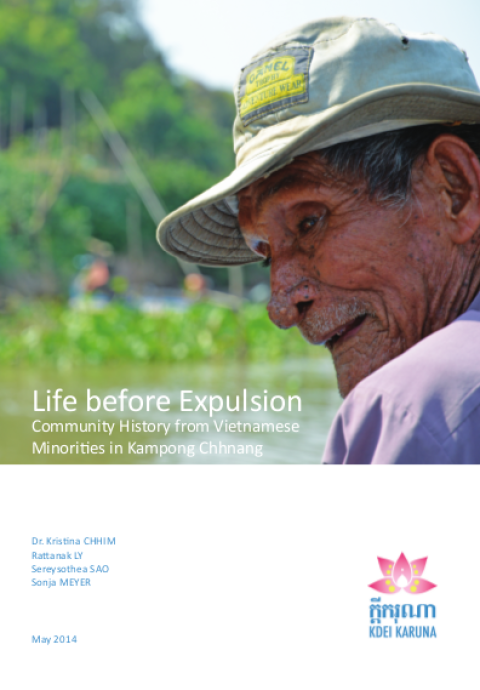Publikation

Life before Expulsion
Ethnic Vietnamese groups have lived in Cambodia throughout contemporary history and the
histories of the countries are closely intertwined. Nowadays, Vietnamese are one of the
largest minority groups in Cambodia. However, the population group remains understudied
and little public information about them is available. This has led to the fact that rumors and
myths that are sometimes captured for political purposes circulate among Cambodian society.
The national election in July 2013 saw much public debate about the place of the country’s
Vietnamese minority. Any discussion needs to start with a proper differentiation, as ‘The
Vietnamese’ in Cambodia are not one monolithic group, but comprise a range of sub-groups
with very diverse backgrounds – long-term residents who were born in Cambodia, recent
immigrants seeking economic opportunities, investors and business people, illegal migrants,
and different types of border traders.
Cambodians have a range of associations with ‘the Vietnamese’. Some think of Vietnamese
food they like to eat like Phó or Samlar Machu Yuon. Others mention technical skills in
carpentry and other constructions. They buy Vietnamese products and the Cambodian
economy benefits from Vietnamese investment. Many Cambodians have Vietnamese
ancestors in their own family trees or have family and friends who married Vietnamese. On a
more negative note, Khmers often associate prostitution and illegal immigration when thinking
of Vietnamese. In addition, Vietnamese migrants and especially investors have been blamed
for stealing and exploiting Cambodian land and resources. Historically, the Vietnamese
“crocodile” is perceived as a threat. In the 17 th and 18 th century increasing waves of
Vietnamese settlers migrated to Kampuchea Krom and gradually “vietnamized” the area. By
the end of the 1700s, the Mekong Delta was inhabited by a majority of Vietnamese and the
area was unified with the rest of Vietnam in 1802. Memories of this territorial loss are deeply
engraved in the minds of many Cambodians and continue to spur fears of territorial invasion
and foreign dominance.
Several waves of immigration into today’s Cambodia can be identified and some of the
Vietnamese families have come in the 19 th century during French colonial times, some even
before. Different regimes have tried to contain or have embraced Vietnamese immigration.
After independence, persecution peaked during the Khmer Rouge regime when the entire
ethnic Vietnamese community was expelled or eradicated. Some of these groups survived in
refugee camps in southern Vietnam and returned after the genocide. Estimates of the number
of immigrants became a major politicized subject and therefore vary greatly. The existing
literature does not provide a reliable assessment of the various claims, but median estimates
range from 300,000 to 500,000. 1 Since their return to Cambodia in the early 1980s, many of
the former refugees have been treated as immigrants by the authorities regardless of their
previous legal status and their potential eligibility for naturalization. The precarious legal
situation of this particular group puts them at the margins of Cambodian society and has
aggravated their social and economic integration.
Like in other parts of the world, borders have shifted throughout history. Despite their fluidity,
they are important markers of identities that occasionally cause resentment and hostility
between groups. The aim of this Oral History project is to shed light into the migration
histories and living conditions of two Vietnamese communities in Kampong Chhnang. The
research seeks to understand how the minority communities emerged and evolved in
Cambodia and what their living conditions were before their expulsion.
Kdei Karuna has started establishing contact with these communities in December 2012, when
a group of NGOs working on transitional justice in the context of the Khmer Rouge Tribunal,
went to visit them together with their lawyers to assess further needs. Some of the villagers
7participate as Civil Parties in the trials against the former Khmer Rouge leaders and seek justice
for the suffering inflicted on them. Trying to find further information about these groups, Kdei
Karuna realized that very little information is available and decided to contribute to filling this
gap by collecting data on the origins of the minority group.
With this Oral History project, Kdei Karuna seeks to explore the memoryscapes of this
marginalized group – the intersection between memories and the space that surrounds them.
Most of our interviewees displayed a strong spiritual connection to their perceived homeland
on the riverbanks of the Tonlé Sap. Their families have inhabited these areas for several
generations. History based on orally transmitted memories plays an important role in rural
areas where older people are often illiterate and the main means of communication remains
verbal. By collecting personal accounts and drawing from diverse viewpoints, the project
contributes to a historical account that incorporates the life stories of the affected individuals
beyond officiated interpretations of historical facts. This approach can awaken historical
empathy and allow for a change in perspectives, an important prerequisite for social
integration and reconciliation.
During four field trips between November 2013 and March 2014, Kdei Karuna has conducted
life story interviews with 33 respondents aged between 49 and 83. During the trips, the
research team stayed in the villages for several days and took part in the communities’
everyday life. We delved into the past of our narrators, explored the stories that were passed
down from their parents and grandparents and discovered what life was like before their total
expulsion in 1975.